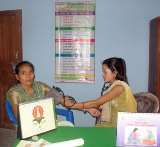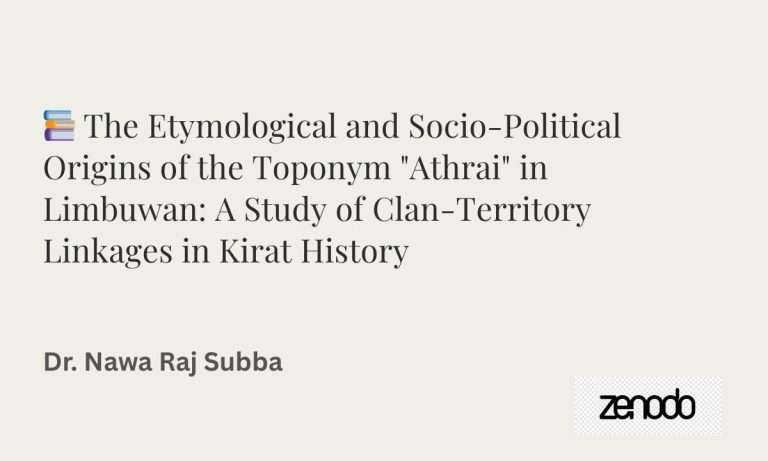Neonatal Health Morang 2006
Nawa Raj Subba

Baseline Report of Morang Innovative Neonatal Intervention 2006
Summary
This is a baseline report of an assessment conducted along with a pilot program on neonatal-health intervention in the Morang district of Nepal. District Public Health Office Morang with the support of JSI (R & T) launched a program called Morang Innovative Neonatal Intervention (MINI) aiming at lowering neonatal deaths by controlling neonatal infections.
Objectives: The objective of this operational research and pilot program aimed to reduce neonatal death rates by controlling neonatal infections.  To fulfill the objective of the program first needed baseline information regarding the neonatal health of the district was completed by pieces of training, supervision, and monitoring during project implementation. Tools are service registers used by Health Workers and FCHVs, reporting formats, service cards, supervision checklists and reports, forms, regular review meetings’ reports, and HMIS data. Primary data was collected through questionnaires and in-depth interviews with health workers and beneficiaries. Data had been regularly entered into the computer and reviewed on monthly basis from July 2004 to September 2006.
To fulfill the objective of the program first needed baseline information regarding the neonatal health of the district was completed by pieces of training, supervision, and monitoring during project implementation. Tools are service registers used by Health Workers and FCHVs, reporting formats, service cards, supervision checklists and reports, forms, regular review meetings’ reports, and HMIS data. Primary data was collected through questionnaires and in-depth interviews with health workers and beneficiaries. Data had been regularly entered into the computer and reviewed on monthly basis from July 2004 to September 2006.
Results
Results: FCHVs have captured 58 percent of expected pregnant women in their wards of VDCs. FCHVs have taken birth weights of 99% babies of registered babies. Of the 12% of babies were found underweight. FCHVs followed up on 83% of these underweight babies. F were assessed as 23% of local bacterial infection and 15% of possible severe bacterial infection. FCHVs first managed 70%, VHWs, and MCHWs first managed 16% and health institutions first managed 14% of Possible Severe Bacterial Infection (PSBI). Of the total 895 PSBIs 39 percent of neonates were treated by home visits and 44% by health facilities. In the intervention area, 68% population has been occupied by Dalits, Indigenous people, and Muslims which are considered Disadvantaged Groups (DAG) in the Morang district. NMR is estimated as 21 per 1000 live births in the district.
Conclusion and Recommendation
Conclusion: Findings showed the progress report of the project. One of the interesting findings is the estimation of the neonatal death rate observed during program intervention which was 21 per 1000 live births in the intervention VDCs of the district. Applying nothing after cutting the umbilical cord caused confusion and complication among mothers, volunteers, and health workers. The neonatal program was coordinated with the child health and maternal health program by which other program results also noted improvements in the villages.
Recommendation: Applying local antibiotics over the umbilical cutting area is recommended to prevent applying other things although health workers asked a mother not to apply anything over there according to the WHO guidelines. Therefore we recommend to the technical authority review the WHO guideline and MINI guidelines to apply local antibiotics over the umbilical cutting areas. The program also felt some incentives for FCHV and CHWs are needed for their overload.
Keywords
Neonatal Mortality, FCHV, VHW, MCHW, Morang.
Background
Background
Nepal is one of the countries having the highest IMR in the world. Since the proportion of NMR is almost constant despite there being a remarkable decrease in IMR over the decade of 1991 to 2001 in the country.[1]
Nepal has experienced the trend of a remarkable decrease in <5 yrs mortality but no changes in neonatal mortality rate. Safe motherhood programs, and Community Based-Integrated Management of Childhood Illness (CB-IMCI) programs are going on in a primary health care package, but it is inadequate to fulfill the requirement of basic neonatal health care services. On this background, National Neonatal Health Policy 2004 has been formulated in the country. The policy has opened rooms for piloting neonatal health care projects in districts.
Morang district has got neonatal health care pilot program named Morang Innovative Neonatal Intervention (MINI), which aims at reducing neonatal deaths by controlling neonatal infections. The neonatal period is classically defined as the first 28 days of life. But, MINI has defined the neonatal period as the first 60 days of life in the program. A similar neonatal program Projahnmo Project Shylet in Bangladesh[2] defined the neonatal period as the first 40 days of life.
Human Development Indicator
Human Development Indicators 2001[3] of Morang district are in better condition in the Eastern region and country as well. But the population size of the district is the second highest in the country and highest in the Eastern development region. A joint effort of the District Public Health Office (DPHO) Morang and Morang Innovative Neonatal Intervention (MINI) or John Snow International (Research & Training) has got two years of achievements and experience in the Morang district. About nine months period has been passed solely in the preparation phase for training for trainers, training for health workers, and FCHVs in the communities. Service intervention was begun in June 2005 in 21 Village Development Committees (VDC) in the district.
Objectives
The objectives of the study are to assess the effectiveness of the program by assessing the situation of neonatal health in the population of intervention VDCs and comparing it with non-intervention VDCs. The objective of the study also includes comparing other existing program performances in intervention and non-intervention VDCs.
Methodology
It is a retrospective comparative assessment. A series of training, supervision and monitoring was conducted during project implementation. Interventions were ANC counseling, baby weight taking, treatment and referral of neonatal infections, and PNC counseling by FCHVs and CHWs. The expected outcome was identifying birth weights, diagnosis of neonatal infection, and treatment or referral to the health institutions. Tools used were service registers used by Health Workers and FCHVs, Reporting Formats, Service Cards, Supervision Checklists, and questionnaires. A study of Secondary data from the MINI database was taken place. Health Management Information System (HMIS), Regular Review Meetings reports, Supervision, and monitoring reports, published reports and forms: birth information (form A), diagnosis record (form B), vital statistics after 2 months (form C) and treatment record (form D) are also taken as tools. Primary data collection by in-depth interviews with health workers and beneficiaries from randomly selected sites using checklists.
Data Processing
Data Processing: Data has been put regularly into the computer under access and excel software and analyzed monthly. DPHO Morang, the District Technical Working Group (DTWG), and the MINI program have fulfilled their responsibilities of managing and analyzing data during the intervention. According to the baseline household survey[4], the selection of VDCs to receive the package of interventions was done by randomly selecting 2 out of 6 PHCs and 4 out of 10 health posts (both done proportionately to the number of VDCs they serve).
Results
Demographic Information
Table 1. Castes and ethnic distribution of service users in the intervention area.
| Caste/Ethnicity | Service received (n=2533) | |
| Number | Percentage | |
| Brahmin | 167 | 14% |
| Chettri | 143 | 12% |
| Newars | 41 | 3% |
| DAG (Dalits, Aadibasi Janajati) | 740 | 62% |
| Muslims | 68 | 6% |
| Others | 37 | 3% |
Table 1 shows the distribution of the caste and ethnicity receiving services in the population from 21 intervention VDCs. In the intervention area, 68% population has been occupied by Dalits, Indigenous people, and Muslims which are considered Disadvantaged Groups (DAG) in the Morang district. Brahmin 14%, Chhetri 12%, Newars 3%, and others 3% have also taken services from this program.
Service Indicators
Table 2. Service indicators regarding Home visits in Intervention Area
| Indicators | Number | % |
| Expected pregnancies in 21 VDCs | 10,282 | |
| Total births recorded by FCHVs | 5,957 | 58 |
| Babies for whom weight was taken by FCHVs among records taken | 5,925 | 99 |
| Low body weight baby recorded | 682 | 12 |
| Low body weight baby attended 4 follow-up visits | 564 | 83 |
| Local Bacterial Infections assessed by FCHVs | 1,381 | 23 |
| Possible Severe Bacterial Infection (PSBI) | 895 | 15 |
| Possible Severe Bacterial Infections first managed by FCHV
– VHW/MCHW | 630
144 | 70
16 |
| The first dose of Gentamicin injected at Home
– Health Facilities | 282
324 | 39
44 |
Table 2 indicates as FCHVs have captured 58 percent of expected pregnant women in their wards of VDCs. It is noted that 58% of households are visited by FCHVs. FCHVs have taken birth weights of 99% of babies for whom weight was taken. Of the 12% of babies were found underweight. FCHVs followed up on 83% of these underweight babies. They assessed 23% of local bacterial infections and 15% of possible severe bacterial infections. FCHVs first managed 70%, VHWs, and MCHWs managed 16%, and 14% managed by health institutions of Possible Severe Bacterial Infection (PSBI). Of a total of 895 PSBIs 39 percent of neonates were treated by home visits and 44% by health facilities. It is noted that these activities are not undertaken by FCHVs in non-intervention VDCs or they usually did not do these jobs.
NMR
Table 3. Neonatal Mortality Rate in Morang following MINI Intervention
| Observations Points | Total Births Recorded | Total Deaths Recorded | NMR per 1000 live births |
| May 2005 (At Beginning) | 420 | 13 | |
| May 2006 (After 1 year) | 6046 | 119 | 21 |
Table 3 shows the status of NMR in Morang. At the beginning of the intervention of MINI, it was total of 13 neonatal deaths were recorded out of 420 births records. After one year of intervention, neonatal deaths had been recorded in 114 out of 6046 births. NMR may be estimated as 21 per 1000 live births in the district. According to the census 2001[5], NMR is 39 per 1000 live births in Nepal.
Table 4. Comparison of the district’s achievement over Pre and Post MINI intervention
| SN | Indicators | 2061/62 | 2062/63 |
| 1 | BCG | 94 | 100 |
| 2 | DPT3 | 73 | 100 |
| 3 | Measles | 80 | 91 |
| 4 | TT2 | 62 | 61 |
| 5 | 4 ANC visits | 40 | 44 |
| 6 | PNC Visit | 38 | 39 |
Table 4 indicates that BCG, DPT3, and Measles vaccination coverage was 94%, 73%, and 80% in the year 2061/62 which increased to 100%, 100%, and 91% respectively in the year 2062/63. Similarly, the Target achievement of TT2, 4ANC visits, and PNC visits in FY 2061/62 was 62%, 40%, and 38% which found 61%, 44%, and 39% respectively in the year 2062/63. Most of the indicators found improved in FY 2062/63 than the previous year.
Comparison between Intervention and non-intervention
Table 5. Comparison of Target Vs Achievement between Intervention and Non-Intervention VDCs
| S.N. | Indicators | Intervention VDCs (21) | Non-Intervention VDCs (44) | ||||
| Target | Achievement | % | Target | Achievement | % | ||
| 1 | BCG | 7256 | 6817 | 94 | 10981 | 10920 | 99 |
| 2 | DPT3 | 7256 | 7382 | 100 | 10981 | 11561 | 100 |
| 3 | Measles | 7256 | 6365 | 88 | 10981 | 10484 | 95 |
| 4 | TT2 | 11436 | 6901 | 60 | 17307 | 12202 | 71 |
| 5 | ANC 4 visit | 11436 | 4613 | 50 | 17307 | 5402 | 47 |
| 6 | PNC Visit | 11436 | 3721 | 33 | 17307 | 5986 | 35 |
Table 5 shows that the achievement of BCG coverage in intervention is 94 percent, whereas it is 99 percent in non-intervention VDCs. Similarly, Measles coverage in intervention VDCs is 88 percent, whereas it is 95 percent in non-intervention VDCs. ANC 4 visit is 50 percent in intervention VDCs whereas it is 47 in non-intervention VDCs. The proportion of delivery conducted by health workers is 12 percent in intervention whereas it is 9 percent in non-intervention VDCs. The status of EPI program coverage in intervention VDCs has been found lower than in non-intervention VDCs. However, coverage or achievement of the rest of the programs such as safe motherhood and nutrition programs has got a positive trend.
Status of PHC-ORC
Table 6. Comparison of Per PHC-ORC Served in between Intervention and Non-Intervention VDCs
| Indicators | Intervention VDCs (21) | Non-Intervention VDCs (44) | ||||
| Clinics | Clients | Per Clinic | Clinics | Clients | Per Clinic | |
| PHC-ORC served (2061/62) | 968 | 32300 | 33 | 1919 | 50296 | 26 |
| PHC-ORC served (2062/63) | 1005 | 31653 | 31 | 2117 | 60618 | 29 |
| The trend of clients per clinic | – | + |
Table 6 shows the number of clients served per clinic was 26 in FY 2061/62 which increased to 29 in 2062/63. Likewise, the number of clients served by a clinic in the intervention was 33 in FY 2061/62 which dropped to 31 in FY 2062/63. Therefore, the trend of PHC-ORC serving per clinic is found to increase in non-intervention VDCs whereas decreased in intervention VDCs. The CPR in Morang is considered to be the highest in the Eastern development region.[6] Its major proportion is occupied by Voluntary Surgical Contraception (VSC).
The researcher attempted to take in-depth interviews with some beneficiaries and health workers during field visits. A mother of a neonate who was recently recovered from the treatment said, “This program is an effective program which takes care of we poor and Dalits people. We are really grateful to the government.” A VHW said “we have got two-three hours more workload after this MINI intervention. Since almost all neonates get well from the treatment community people and/or caretakers have acknowledged our treatment. Now we have found ourselves differently in our profession. We are satisfied with the program. Although it might have affected to conduct of the EPI-ORC, and PHC-ORC sessions, we are trying to manage it.”
Problems
Some technical problems are found in the treatment protocol which may require consideration. As per our protocol, health workers leave the cut umbilicus by applying nothing. Some caretakers are tended to put dust over the umbilicus since they see fresh bleeding. One case of neonatal infection such an incident was investigated in the district. Therefore, the application of antiseptic on the umbilical cord is felt the need for health workers as they often reported in the review meetings. It is subject to be reviewed in the infection control protocol.[7]
Discussion
According to the DoHS Annual Report 2004/2005,[8] the ANC first visits as % expected a pregnancy is 77.7% in Morang and the national average is 68.8%. The highest numbers of neonatal deaths are in south-central Asian countries and the highest rates are generally in sub-Saharan Africa. The countries in these regions (with some exceptions) have made little progress in reducing such deaths in the past 10–15 years. Globally, the main direct causes of neonatal death are estimated to be preterm birth (28%), severe infections (26%), and asphyxia (23%).
Neonatal tetanus accounts for a smaller proportion of deaths (7%) but is easily preventable. Low birth weight is an important indirect cause of death. Maternal complications in labor carry a high risk of neonatal death, and poverty is strongly associated with an increased risk. Preventing deaths in newborn babies has not been a focus of child survival or safe motherhood programs. While we neglect these challenges, 450 newborn children die every hour, mainly from preventable causes, which is unconscionable in the 21st century.[9]
Nepal
There is considerable interest in Nepal and other countries in addressing neonatal mortality. Nepal has demonstrated a remarkable decline in infant and child mortality over the past 2 decades. However, there has been less improvement in neonatal mortality, and an increasing proportion of under-5 deaths (40%) are now in the neonatal period.[10] The proportion of home delivery in intervention VDCs of Morang[11] district is 69.6% which is still the vast majority of 86.7% in Kailali[12] and its national[13] average is 88.9%.
Compared to NDHS 2001
Nepal Demographic and Health Survey 2001 has estimated that in Nepal nearly 50,000 children under one year of age die every twelve months. Two third of them die within 28 days of age, resulting in 30,000 neonatal deaths per year. This means three to four newborns are dying every hour in Nepal. The majority (86.1%) of deaths occurred at home, with only 141 (13.2%) occurring at the health facility.[14] A study of low birth weight from four regional hospitals has found a weighted mean incidence of 27%. The strongest risk factors for low birth weight were maternal weight, previous preterm delivery, short birth interval, and paternal employment in Agriculture.[15]
People have well-accepted neonatal health services provided by FCHV, MCHW, and VHW at the community level. Mothers feel convenient home visits since they are reluctant to take out their neonates from the house due to the cultural barrier. Now, people are gradually changing their attitudes and behavior regarding taking care of neonatal care in time. People are impressed with the cure rate of Gentamicin injection. Neonates got well from the treatment even those neonates who were given up their hope by their parents to live any longer.
Status of Community Health Workers
VHWs and MCHWs play a vital role in the MINI program. They have provided home visits for curative services at home. This is one of the first programs which have established a warm relationship with people by health workers at the door of clients. The community has recognized health workers are helpful to us and save the life of neonates from the mouth of death in our own houses. Recognition from people is one of the major factors which made health workers motivated toward the neonatal health program. The district health system has accepted this program as a part of its own regular program which is need-based and useful. Now, the system has adopted this program and can run even after support from partners would not be any longer.[16]
This program has been able to include socially marginalized castes and ethnicities who are hard to access due to socio-economic and cultural factors. Service users from disadvantaged groups such as Dalits, indigenous people, and Muslims comprised 60 percent of the total service users population.
Trends
So many positive trends in safe motherhood, family planning, and CB-IMCI have been reported. But EPI coverage and coverage of PHC-ORC are adversely affected by the program since it is relatively lower than the non-intervention area. Routine immunization and PHC-ORC are adversely affected due to double responsibilities of attending Gentamicin injection and EPI session or PHC-ORC on the same day. This is a big challenge for district management which requires due attention for the prevention of adverse effects on EPI sessions and PHC-ORC.
Review meetings report[17] on reproductive health or safe motherhood program have revealed issues to be considered while formulating comprehensive maternal and child health programs in the district. There was already a provision of Birth Preparedness Packages (BPP) for TBA in the district. Success is possible in low-income countries without access to high technology.[18] A supportive partner BNMT put some of its efforts into the promotion of BPP in selected VDCs. But it has been reported that it was inadequate. More orientations for TBAs and pregnant women are needed and more IEC materials are to be produced for all VDCs in the district.
Conclusion
District Public Health Office Morang with the help of JSI (R & T) launched a MINI program that has involved Community Health Workers and Female Community Health Volunteers aiming to lower neonatal deaths in the district. Remarkable numbers of neonates are covered by the program. Morang district has got estimated NMR of 21/1000 live births in 2006. The neonatal health program is coordinated with the existing public health program. But the performance of EPI-ORC and PHC-ORC is slightly decreased in the intervention area which demands close and regular monitoring. However, incentives for FCHV such as providing bicycle, dress, and monthly meeting allowance are necessary. Similarly, an incentive package for Community Health Workers (CHW) is also required to make effective neonatal healthcare programs.
Recommendation on neonatal health in Morang
District Public Health Office Morang recommended applying local antibiotics over the umbilical cutting area to prevent applying other things although health workers asked a mother to apply nothing over the area according to the WHO guidelines. Therefore we recommend to the technical authority review the WHO guideline and MINI guidelines like applying local antibiotics over the umbilical cutting area. The program also felt some incentives for FCHV and CHWs since they are overloaded with the program and responsibility.
Acknowledgment
The researcher duly acknowledges the support of JSI R&T for technical and financial support. Sincere thanks go to Dr. B.D. Chataut, Dr. Neena Khadka, Dr. Penny Dawson, Dr. Sudhir Khanal, and Dr. Jagannath Sharma, for providing technical guidelines for the program. Thanks also go to Mr. Ram Bahadur Baniya, Mr. Vijay Sing GC, Mr. Tekraj Koirala, and all DPHO and MINI staff for playing a vital role in project implementation with keeping mutual cooperation. Last but not least thanks go to the District Technical Working Group (DTWG) for the support and guidance.
References
[1] DoHS. National Neonatal Health Policy 2004, Department of Health Services, Teku, Kathmandu, Nepal, 2004.
[2] Peter J Winch, M Ashraful Alam, Afsana Akther, et.al. Local understandings of vulnerability and protection during the neonatal period in Sylhet district, Bangladesh: a qualitative study, Lancet 2005; 366: 478–85.
[3] UNDP. Report on the Human Development Index. 2004.
[4] DPHO, JSI, SNL. Baseline Survey Report on Neonatal Health in Morang District Nepal. 2005.
[5] CBS. Census Report. National Planning Commission, Central Bureau of Statistics, Kathmandu Nepal, 2001.
[6] ERHD. Annual Reports, MoHP, Eastern Regional Health Directorate Dhankuta, 2057/58, 2058/59, 2059/60, 2060/61, 2061/62.
[7] Luke C Mullany, Gary L Darmstadt, Subarna K Khatry, et al. Topical applications of Chlorhexidine to the umbilical cord for prevention of Omphalitis and neonatal mortality in southern Nepal: a Community-based, cluster-randomized trial. Lancet 2006; 367: 910–18.
[8] DoHS. Annual Report, Ministry of Health and Population, Department of Health Services, Kathmandu, Nepal, 2004/2005.
[9] Joy E Lawn, Simon Cousens, Jelka Zupan. Where? Why? neonatal death www.thelancet.com retrieved on March 5, 2005.
References
[10] UNICEF. Nepal Multiple Indicator Surveillance. Fifth Cycle: Care During Pregnancy and Delivery: Implications for Protecting the Health of Mothers and their Babies. June 1998.
[11] DPHO Morang/MINI. Baseline Survey Report on Neonatal Health in Morang District Nepal. 2005.
[12] SNL/CSF. Baseline Survey Report on Saving Newborn Lives in 18 VDCs and 1 municipality of Kailali, 2003.
[13] DoHS. Demographic and Health Survey, Ministry of Health Department of Health Services, 2001.
[14] F. Baiden1, A. Hodgson1, M. Adjuik1, et.al. Trend and causes of neonatal mortality in the Kassena– Nankana district of northern Ghana, 1995–2002, Tropical Medicine and International Health, Volume 11 no 4 pp 532–539 April 2006.
[15] MIRA/UNICEF. Low Birth Weight prevalence and associated factors in four regions of Nepal, Kathmandu. 2000.
[16] Subba NR. Assessment Report on Morang Innovative Neonatal Intervention. 2006.
[17] DPHO, Annual report, District Public Health Morang. 2061/62.
[18] Jose Martines, Vinod K Paul, Zulfiqar A Bhutta, et.al. Neonatal survival: a call for action. Lancet 2005; 365: 1189–97.



